Cacti are the heart and soul of desert gardening, and in New Mexico, they shine like nowhere else. With their bold shapes, vibrant blooms, and tough-as-nails nature, these plants are both beautiful and incredibly practical. Exploring the many types of cactus in New Mexico opens up a world of color, texture, and low-maintenance charm that suits both rural landscapes and urban backyards.
New Mexico’s sun-drenched climate, rocky soils, and varied elevations provide the perfect backdrop for dozens of cactus species. Some stand tall with towering spines, while others form dense, flowering mats close to the ground. I’ve grown and admired many of these cacti across seasons—watching them bloom after monsoon rains or survive frosty desert nights—and each one brings something special to the garden.
This guide introduces 20 of the most rewarding types of cactus in New Mexico to grow. From native favorites to showy standouts, these selections offer beauty, resilience, and ecological value to any landscape. Get ready to meet some of the toughest and most stunning plants the Southwest has to offer.
Best Cactus Varieties to Grow in New Mexico
Claret Cup Cactus (Echinocereus coccineus)
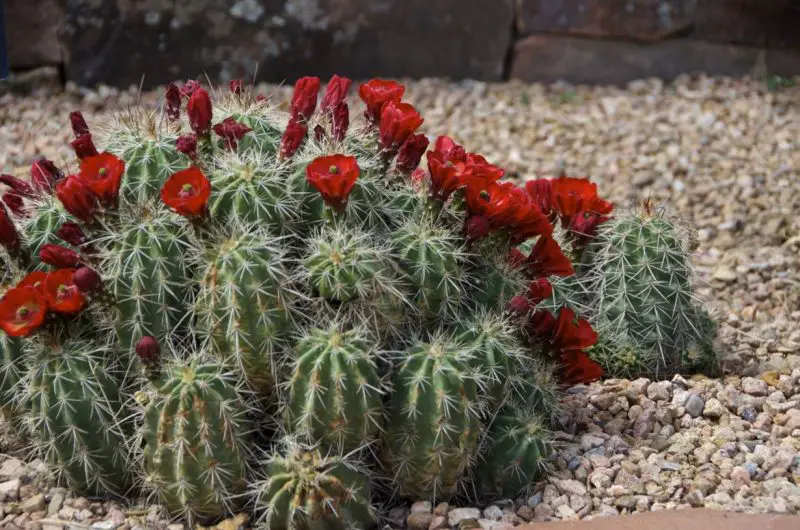
The Claret Cup Cactus is a low-growing, clumping cactus known for its striking red-orange flowers and dense spines. Native to the deserts and foothills of the American Southwest, this species is particularly well-suited for the arid climates of New Mexico. It typically forms clusters of cylindrical stems that grow up to 12 inches tall, creating a mound that spreads over time.
In late spring to early summer, usually between April and June, this cactus bursts into vivid claret-red blooms that attract hummingbirds and pollinators. The flowers are cup-shaped, about 1.5 to 3 inches wide, and can last for several days, creating a spectacular display against the green stems. Flowering is more prolific when the plant receives full sun and proper drainage.
Claret Cup Cactus thrives in USDA zones 5 to 9, making it cold-hardy enough for most parts of New Mexico. It prefers sandy or rocky soils and requires minimal watering once established. Plant it in a sunny, well-drained location and avoid overwatering, especially in the winter. This species is ideal for xeriscaping, rock gardens, or container planting.
Cane Cholla (Cylindropuntia imbricata)

Cane Cholla is a visually striking cactus with a tree-like form that can reach 4 to 6 feet tall, often with a branching, upright structure. It is native to the high deserts of New Mexico and is highly adapted to drought and poor soils. The stems are jointed and covered in sharp, barbed spines, which serve as a defense against herbivores.
This species produces vibrant magenta to purple flowers in late spring or early summer, typically blooming from May to June. The flowers are followed by yellow, pear-shaped fruits that often persist into winter, adding ornamental interest. The blooms are pollinated by bees and other native insects, contributing to local biodiversity.
Cane Cholla grows well in USDA zones 6 to 9 and prefers full sun with well-draining soil. It tolerates heat and cold alike and requires little to no supplemental irrigation after establishment. Propagation is easy through stem cuttings, but gloves are recommended due to the spines. Use this plant in xeric landscapes, erosion control, or as a barrier hedge.
Tree Cholla (Cylindropuntia arborescens)
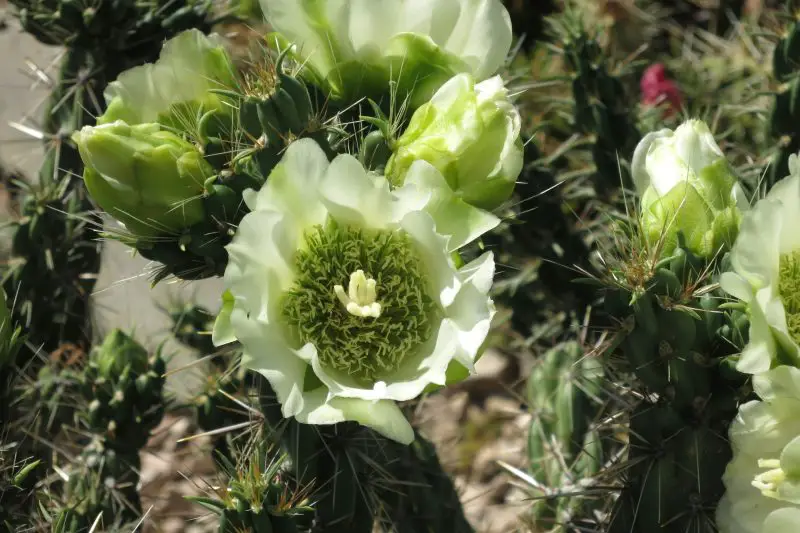
Tree Cholla is a tall, shrubby cactus native to arid and semi-arid regions of New Mexico, often growing up to 9 feet high. It has a woody trunk and thick, segmented branches that give it a sculptural, tree-like appearance. Its spines are long and silvery, often creating a shimmering effect in the sun.
The flowers of Tree Cholla range from deep magenta to lavender and bloom from May to early July. The blooms are followed by green to yellowish fruits that may remain on the plant into the winter months. These colorful blossoms are not only beautiful but also provide nectar for bees, butterflies, and birds.
This cactus prefers full sun and well-drained soils and is suited for USDA zones 6 to 9. It tolerates both high heat and freezing temperatures and requires minimal maintenance. To plant Tree Cholla, choose a site with gravelly or sandy soil and avoid areas prone to waterlogging. It makes a dramatic addition to desert gardens or as an architectural accent.
Walkingstick Cholla (Cylindropuntia spinosior)
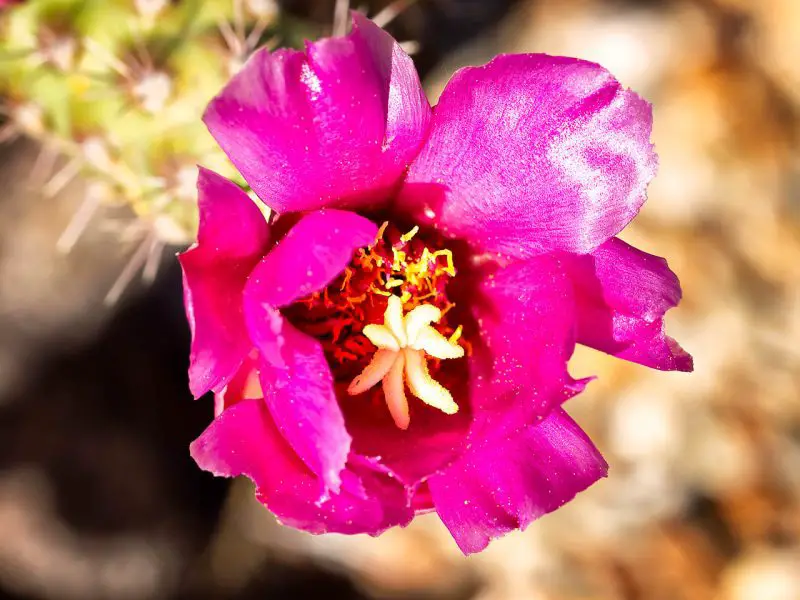
Walkingstick Cholla is a robust and tall cactus species with densely spined, cylindrical stems that can reach up to 7 feet in height. The joints are thick and sometimes curved, giving the plant its common name due to their resemblance to walking sticks. Native to southern parts of New Mexico, it is well adapted to desert and semi-desert conditions.
This cactus displays a wide variety of flower colors, including magenta, pink, orange, and even yellow, usually blooming between May and July. The blossoms are eye-catching and are followed by yellowish, fleshy fruits that sometimes last through fall. Its floral diversity makes it a standout species in native plant landscapes.
Walkingstick Cholla thrives in USDA zones 6 to 9, preferring dry, rocky soils and full sunlight. It is drought-tolerant and cold-hardy, making it ideal for xeriscaping in New Mexico. Regular pruning is not needed, but care should be taken when handling due to its extremely sharp spines. Plant in a spacious location where its size and shape can be fully appreciated.
Whipple’s Cholla (Cylindropuntia whipplei)
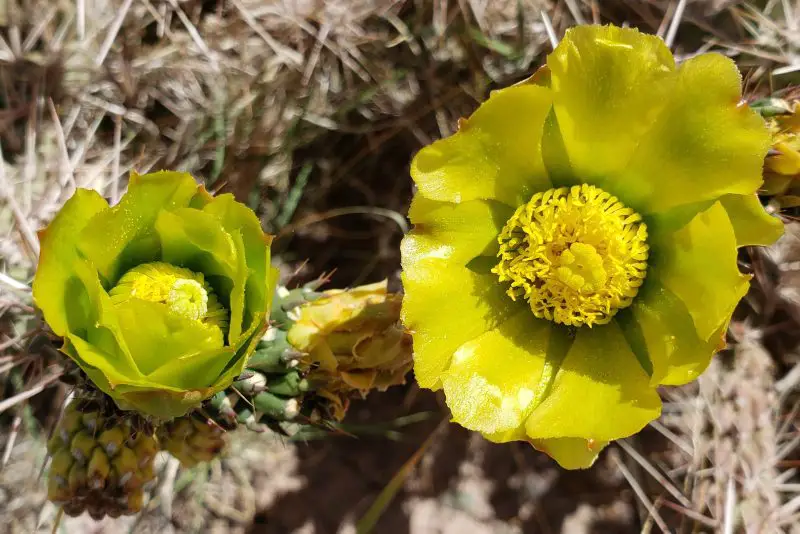
Whipple’s Cholla is a small to medium-sized cactus native to the higher elevations of New Mexico, typically reaching 1 to 3 feet in height. It features slender, jointed stems covered in short, dense spines that give it a grayish appearance. This species often forms low, spreading colonies and is especially common in grasslands and piñon-juniper woodlands.
Flowers appear in late spring to early summer, usually from May to June, and are typically greenish-yellow with hints of pink or purple. The flowers are less showy than those of other cholla species, but their subtle coloration is attractive in naturalistic settings. Small, dry fruits follow and provide food for wildlife.
Whipple’s Cholla is adapted to USDA zones 5 to 9 and is particularly tolerant of colder temperatures, making it suitable for higher elevations in New Mexico. It requires well-drained soils, preferably sandy or rocky, and full sun exposure. This species is a good choice for native plant gardens, wildlife habitats, and erosion control on slopes.
Desert Christmas Cactus (Cylindropuntia leptocaulis)

The Desert Christmas Cactus is a slender, shrubby cholla known for its narrow green stems and modest size, typically growing 1 to 3 feet tall. Its joints are pencil-thin and somewhat flexible, giving the plant a wiry, sprawling appearance. Though not as imposing as other chollas, it’s easily recognized by its delicate structure and scattered spines.
This cactus gets its name from the small red berries that appear in winter, often around Christmas time. Its flowers bloom in late spring or early summer, usually May to June, and are small, yellowish-green to pale yellow. While not particularly showy, the flowers attract native bees and are followed by bright red fruits that persist into the colder months, adding color to the desert landscape.
Desert Christmas Cactus thrives in USDA zones 7 to 10 and prefers dry, sandy soils with full sun exposure. It is highly drought-tolerant and requires very little maintenance once established. Due to its subtle beauty and winter interest, it’s ideal for low-water landscapes, desert gardens, and naturalized plantings across southern New Mexico.
Engelmann’s Prickly Pear (Opuntia engelmannii)
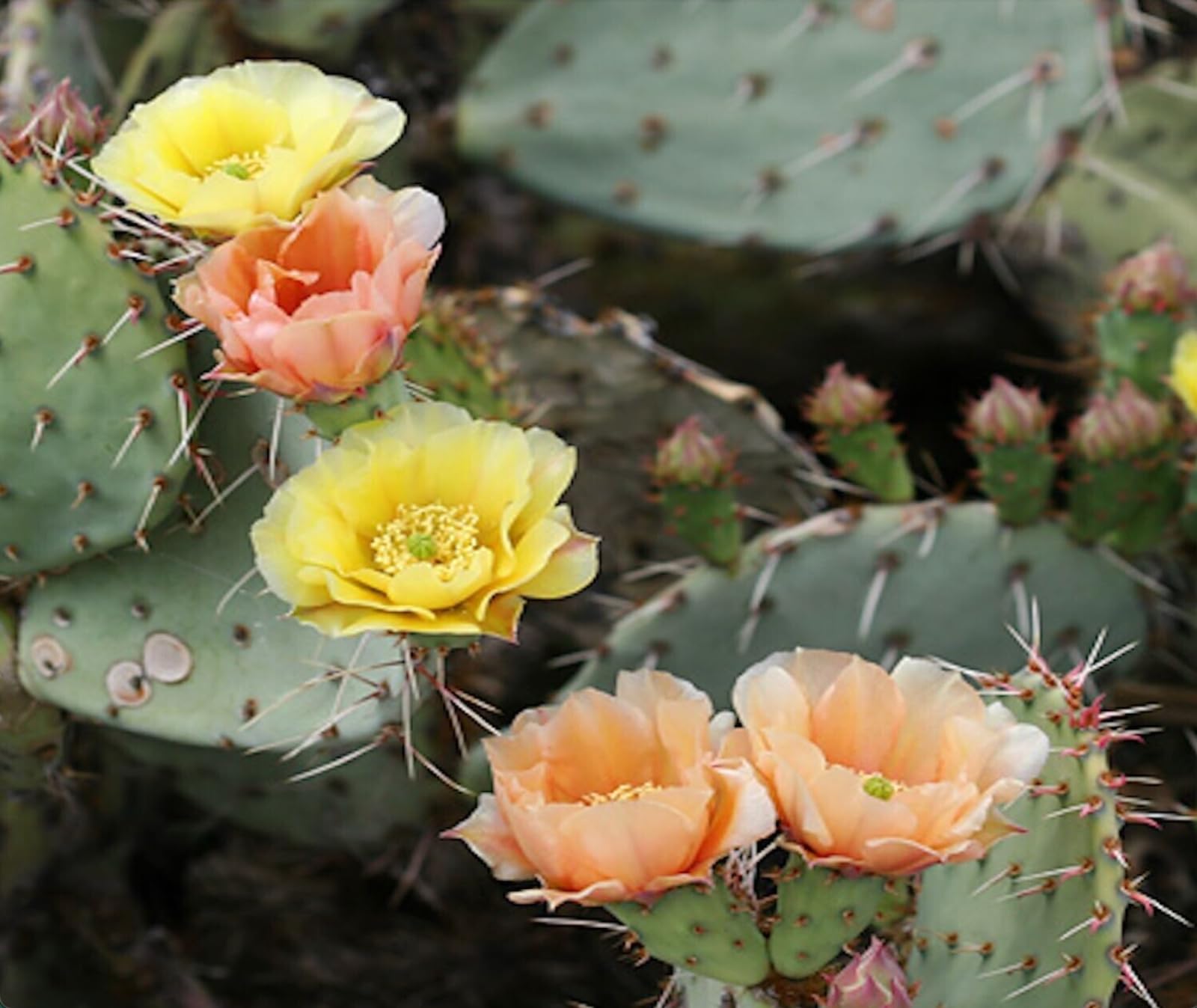
Engelmann’s Prickly Pear is one of the most iconic and widely distributed cacti in the Southwest. It forms sprawling clumps up to 5 feet tall and wide, with broad, flat pads (cladodes) that are covered with clusters of barbed spines and fine glochids. These pads store water efficiently, allowing the plant to thrive in arid conditions.
The large, yellow flowers bloom in late spring, typically from April to June, and sometimes have a reddish tint at the base of the petals. These showy blooms attract bees and other pollinators and are followed by purplish-red, edible fruits known as “tunas.” The fruits and pads are used in traditional Southwestern cuisine and medicine.
Hardy to USDA zones 7 to 10, Engelmann’s Prickly Pear is well-suited to much of New Mexico’s climate. It prefers full sun and well-drained soil and should be watered sparingly. It tolerates both heat and cold and is excellent for xeriscaping, erosion control, or use in natural desert-style gardens.
Plains Prickly Pear (Opuntia polyacantha)

Plains Prickly Pear is a cold-hardy cactus species native to the high plains and foothills of New Mexico. It grows in low, spreading mats up to 12 inches tall and several feet wide. The pads are oval to round, with variable numbers of sharp spines that can range from short to very long and white to brown in color.
This species produces showy flowers in shades of yellow, orange, or pink, usually blooming in late spring to early summer, from May to June. The flowers are about 2 to 3 inches wide and are followed by small, dry fruits. Plains Prickly Pear’s adaptability to both high elevation and arid environments makes it ideal for colder regions of the state.
It grows best in USDA zones 4 to 9 and can tolerate freezing temperatures as well as extreme heat. It prefers full sun and gravelly or sandy soils and is very drought-tolerant. This cactus is well-suited for native plant landscapes, prairie restorations, and areas with poor soil or limited water.
Tulip Prickly Pear (Opuntia phaeacantha)
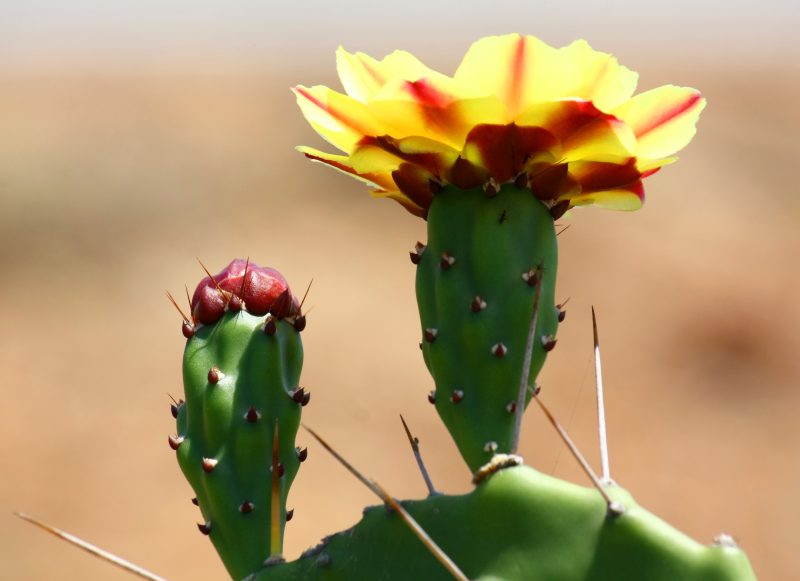
Tulip Prickly Pear is a common and beautiful cactus found across much of New Mexico, growing 1 to 3 feet tall with spreading clumps of blue-green pads. It gets its name from its tulip-like flowers, which are usually golden-yellow with orange or red centers, creating a fiery gradient that stands out in desert landscapes.
The plant blooms in late spring through early summer, generally from May to July. Its flowers are large and vibrant, attracting pollinators like bees and butterflies. The resulting fruits are reddish-purple and pear-shaped, often used by wildlife and occasionally harvested for human use.
Tulip Prickly Pear is hardy in USDA zones 5 to 9 and thrives in dry, well-drained soils under full sun. It requires little water and is highly tolerant of drought and heat. It’s an excellent choice for rock gardens, xeriscaping, and native habitat restoration projects throughout New Mexico.
Purple Prickly Pear (Opuntia macrocentra)
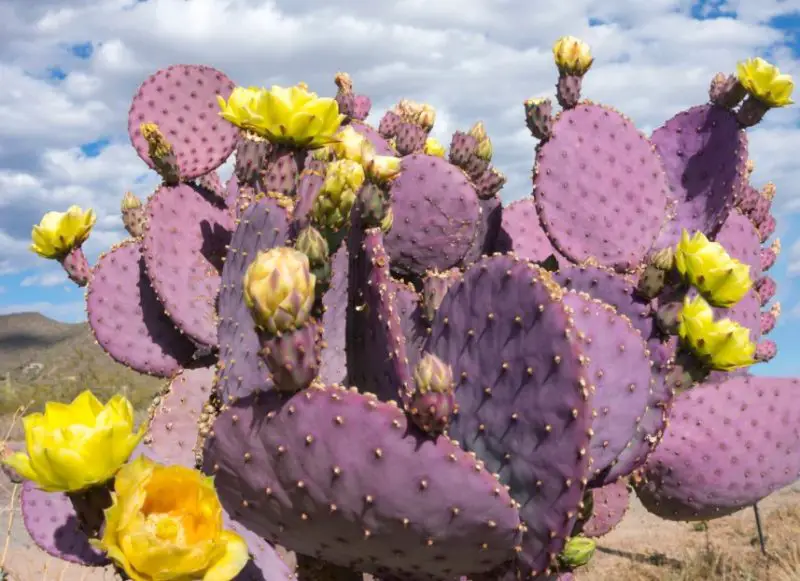
Purple Prickly Pear is one of the most visually striking cacti in New Mexico, known for its bluish-purple pads that become more vibrant in winter or under stress. It typically grows in low clumps 2 to 4 feet tall and wide, with long, dark central spines and short radial spines. Its coloration makes it a favorite in ornamental desert gardens.
The flowers are bright yellow with contrasting red or orange centers and bloom from April to June. These dramatic blooms provide a stunning contrast to the purple pads. After blooming, the cactus produces deep red fruits that can persist into the fall, offering food for birds and small mammals.
This species does well in USDA zones 6 to 9 and prefers full sun and well-drained, sandy or rocky soils. It is drought-tolerant, cold-hardy, and very low maintenance. Ideal for southwestern-themed landscapes, Purple Prickly Pear adds unique color and texture while thriving in New Mexico’s harsh, dry conditions.
Mojave Prickly Pear (Opuntia erinacea)
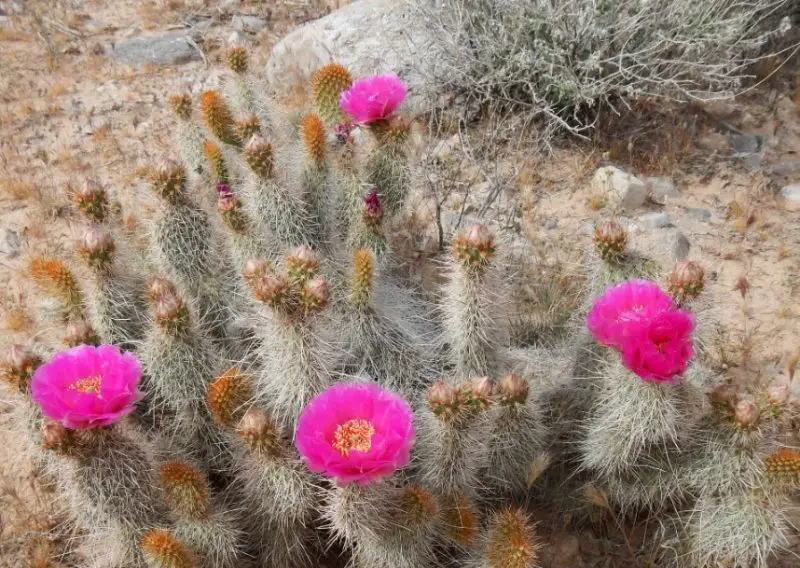
The Mojave Prickly Pear is a hardy, low-growing cactus with round, gray-green pads covered in dense clusters of fine spines and longer central spines that vary from yellow to dark brown. It typically grows 1 to 2 feet tall and spreads widely across rocky or sandy terrain. The pads may appear woolly or fuzzy due to the thick covering of spines, which help reduce water loss in arid conditions.
Flowers are usually bright pink to magenta and bloom from May to June. They are cup-shaped and around 2 to 3 inches wide, often covering the plant in vivid color. After blooming, the cactus produces small, dry, reddish fruits that are less fleshy than those of other prickly pears but are still attractive to wildlife.
This cactus is well-suited for USDA zones 5 to 9, thriving in full sun and extremely well-drained soils. It handles high desert cold and drought very well, making it a perfect fit for the mountainous and arid regions of New Mexico. Once established, it requires very little water and is an excellent choice for xeriscapes, rock gardens, and erosion-prone slopes.
Beavertail Cactus (Opuntia basilaris)

The Beavertail Cactus is a spineless prickly pear known for its flat, bluish pads that resemble the shape of a beaver’s tail. Instead of long spines, its pads are dotted with tiny glochids that can still irritate skin. The plant generally grows 1 to 2 feet high and can form dense clumps several feet wide in arid desert landscapes.
Its large, rose-pink to magenta flowers bloom from March to May, depending on elevation and temperature. These vibrant flowers are a major pollinator magnet and are often among the earliest to appear in the spring desert bloom. The flowers are followed by dry, oval fruits that persist into summer.
Beavertail Cactus thrives in USDA zones 6 to 10, requiring full sun and sandy or gravelly soil with excellent drainage. It is extremely drought-tolerant and prefers dry conditions, making it ideal for low-water landscapes in southern and western New Mexico. Avoid overwatering, and plant it in raised beds or slopes to prevent root rot.
Fendler’s Hedgehog (Echinocereus fendleri)
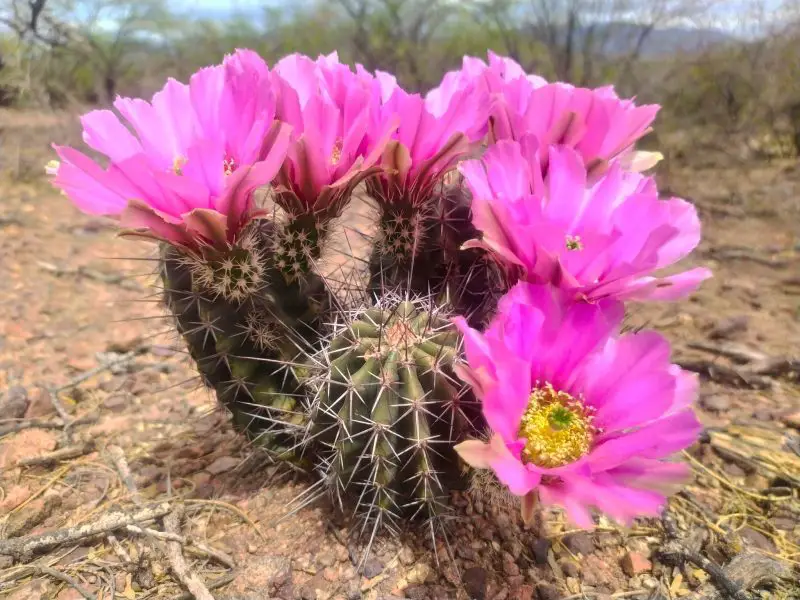
Fendler’s Hedgehog is a compact, cylindrical cactus often found in clumps with 3 to 12 stems. It reaches about 6 to 12 inches in height and is covered in clusters of white to gray spines. Native to rocky slopes and high desert regions, it is one of the most common hedgehog species in New Mexico.
Its large, magenta to deep pink flowers bloom in late spring, typically April to May. The flowers are funnel-shaped and can be several inches wide, often forming striking crowns atop the stems. Fruits are small, greenish-red, and edible, though not widely harvested.
Fendler’s Hedgehog does well in USDA zones 5 to 9. It thrives in full sun and well-drained rocky or sandy soils. This species is drought-resistant and can tolerate colder temperatures, making it suitable for both high desert and lower elevation regions of New Mexico. Minimal watering and good air circulation are key to healthy growth.
Lace Hedgehog (Echinocereus reichenbachii)
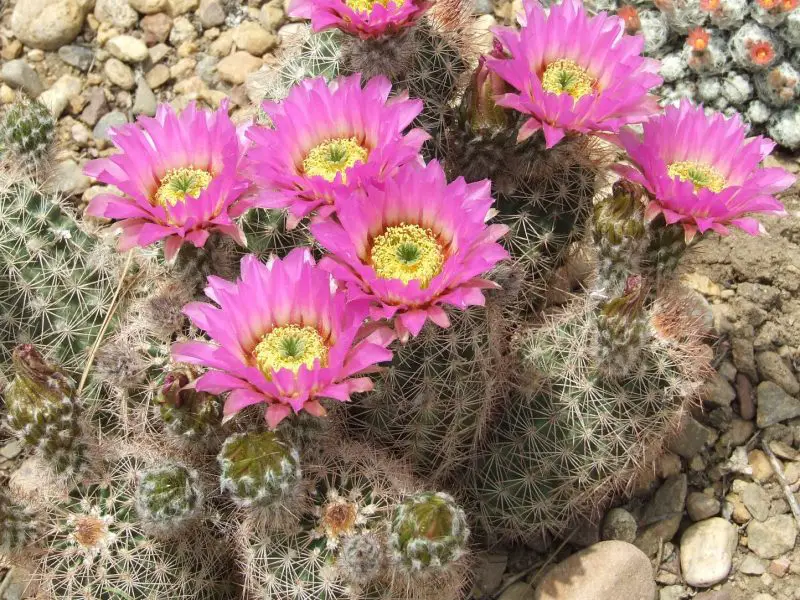
Lace Hedgehog Cactus is a small, low-growing species known for its delicate, lace-like white spines that almost obscure the green stem underneath. It rarely grows taller than 6 to 8 inches and usually remains solitary or in small clusters. Its fine spines help reflect sunlight and retain moisture in arid environments.
The cactus blooms in late spring, typically May to June, with large, light pink to purple flowers that can span 3 inches wide. The center of the flower often displays a striking array of yellow stamens. The flowers are followed by small, green fruits that split open when ripe.
This species is cold-hardy to USDA zone 5 and prefers dry, well-drained soils in full sun. It is perfect for rock gardens, containers, or natural desert landscaping in central and northern New Mexico. It needs minimal watering and should be protected from excessive moisture, especially in winter.
Green-flowered Hedgehog (Echinocereus viridiflorus)
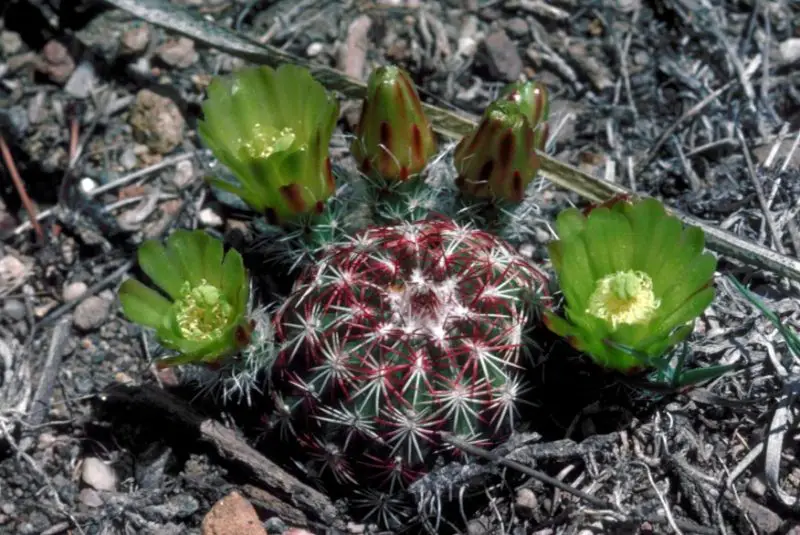
The Green-flowered Hedgehog is a distinctive cactus recognized by its unusual yellowish-green to lime-green blooms. It grows as small, cylindrical stems with dense, short spines that vary in color from reddish to gray. Plants are usually solitary or grow in tight clusters, typically no more than 6 inches tall.
Flowering occurs from April to May, with blooms that have a subtle beauty compared to more vividly colored cacti. The green flowers may include reddish or brownish markings in the throat and are lightly fragrant. Fruits are small and dry, often hidden among the spines.
This cactus is native to higher elevations and is well-adapted to USDA zones 4 to 8. It grows best in sunny, well-drained rocky soils and can tolerate frost and occasional snow. Green-flowered Hedgehog is an excellent option for gardeners in northern New Mexico looking for unique, hardy desert plants.
Strawberry Cactus (Echinocereus stramineus)
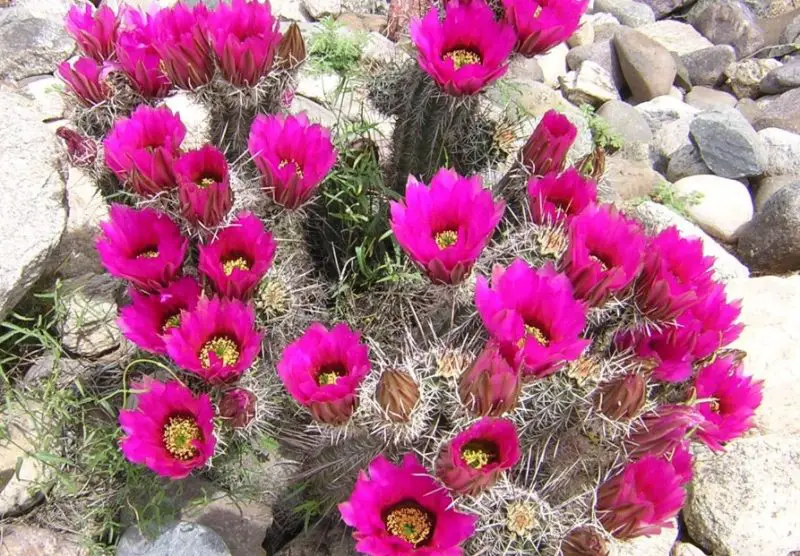
Strawberry Cactus forms low, clumping colonies of thick, spiny stems that can reach 1 to 2 feet tall. The stems are cylindrical and covered in straw-colored spines, giving the plant a bristly appearance. It is typically found in desert flats, limestone outcrops, and gravelly washes.
Large, bright magenta to pink flowers bloom in late spring, usually April through May, often covering the plant in dazzling color. The fruits that follow are sweet and strawberry-flavored, hence the common name. These reddish fruits are edible and were traditionally harvested by indigenous peoples.
Best grown in USDA zones 7 to 10, Strawberry Cactus thrives in full sun with well-draining caliche or sandy soil. It is well-suited to southern New Mexico’s hot, dry climate and performs best with minimal irrigation. Ideal for rock gardens and native landscapes, it requires little maintenance and offers both ornamental and edible value.
Arizona Rainbow Cactus (Echinocereus rigidissimus)
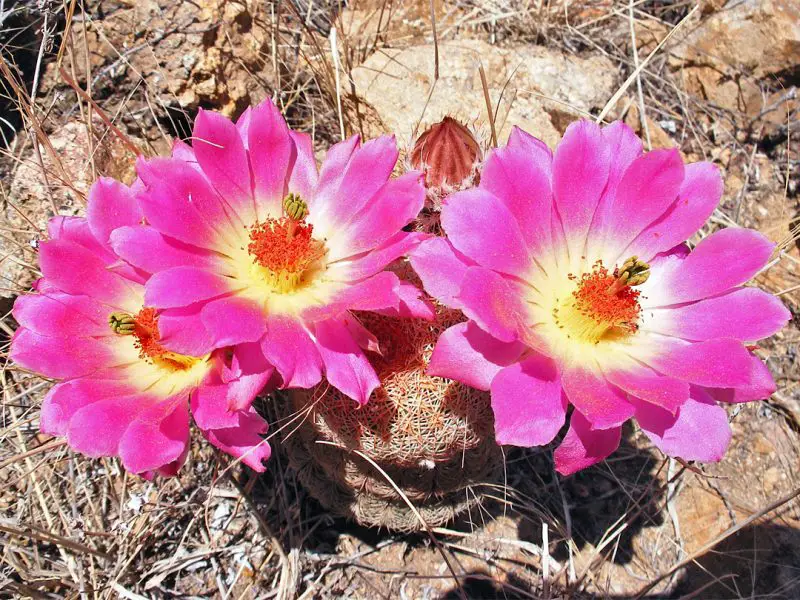
The Arizona Rainbow Cactus is one of the most visually stunning cacti, with dense rings of white, pink, and purple spines arranged in a tight, symmetrical pattern. It grows as a single columnar stem, usually 6 to 12 inches tall, and does not branch or clump like many others in its genus.
The large, funnel-shaped flowers bloom in late spring or early summer, typically May to June. Flowers are bright pink to magenta with white centers and appear at the top of the stem. After flowering, it produces small, dry fruits that are often overlooked but appreciated by wildlife.
Rainbow Cactus is hardy in USDA zones 7 to 10 and thrives in hot, dry conditions with full sun exposure. It requires extremely well-drained soil and should be watered sparingly, especially during winter dormancy. This cactus is a favorite among collectors and is perfect for containers, rock gardens, and arid landscapes in southern New Mexico.
Fishhook Cactus (Mammillaria spp.)

The Fishhook Cactus group includes several small, round to cylindrical species characterized by their curved central spines, which resemble fishhooks. These spines often protrude in a radial pattern and can be reddish or brown. These cacti are typically under 6 inches tall and grow singly or in tight clusters, making them excellent choices for small-scale xeriscaping or rock gardens.
Mammillaria grahamii, also known as Graham’s Nipple Cactus, produces pink to lavender flowers arranged in a ring near the top of the stem, usually blooming from June to August after summer rains. Mammillaria meiacantha, the Many-spined Nipple Cactus, has denser spines and pale pink flowers that appear in early summer. Both species produce tiny red fruits resembling miniature chili peppers.
Fishhook cacti thrive in USDA zones 6 to 9. They prefer full sun and extremely well-draining, gritty soil. These cacti are drought-tolerant and cold-hardy in New Mexico’s desert and foothill environments. Water only during the growing season, and protect from prolonged winter moisture to prevent rot.
Pincushion Cactus (Escobaria spp.)
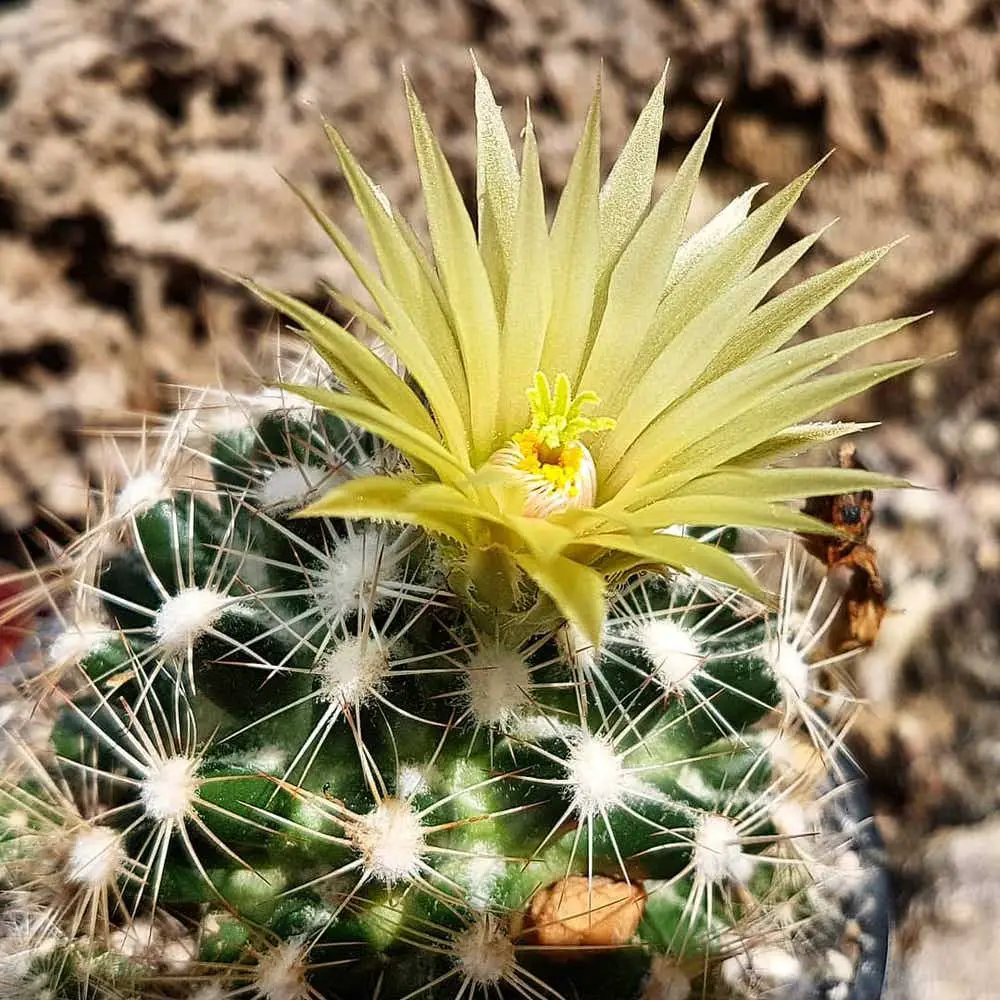
Escobaria species, commonly known as pincushion cacti, are closely related to Mammillaria and grow as small, rounded stems covered with interlaced spines. They typically remain under 6 inches tall and can form small clumps over time. These cacti are native to rocky slopes, desert grasslands, and arid hillsides throughout New Mexico.
Escobaria vivipara, or Spinystar, produces brilliant magenta to pink flowers in late spring to early summer, usually May through June. The Missouri Foxtail Cactus (Escobaria missouriensis) has yellowish or greenish flowers with reddish tips and blooms slightly earlier, often in May. Both species bear small, fleshy fruits that attract birds and other wildlife.
These cacti are cold-hardy to USDA zone 4 and thrive in full sun with sandy, rocky, or gravelly soil. Their tolerance to both summer heat and winter cold makes them ideal for high desert gardens in northern and central New Mexico. Minimal water is needed, and they benefit from excellent drainage and full exposure to sunlight.
Barrel Cactus (Ferocactus wislizeni)

The Barrel Cactus, also known as Arizona Barrel or Compass Barrel, is a large, stout cactus that can grow up to 5 feet tall and 2 feet wide. It is typically ribbed and covered with thick, hooked spines that range in color from yellow to reddish-brown. Over time, the cactus often leans toward the southwest, hence the nickname “compass cactus.”
In New Mexico, this cactus blooms from July to September, with bright yellow to orange flowers that appear in a crown-like ring at the top of the plant. These flowers are followed by spiny, lemon-shaped yellow fruits that persist into winter. The cactus blooms later in the season compared to many others, adding late-summer color to desert landscapes.
Ferocactus wislizeni grows well in USDA zones 8 to 10, thriving in full sun and well-drained, rocky soil. It is ideal for southern New Mexico, especially in the Chihuahuan Desert. This species requires occasional deep watering during hot, dry months but should remain dry in winter. Plant it away from foot traffic due to its sharp spines.
Southwestern Barrel Cactus (Ferocactus cylindraceus)

The Southwestern Barrel Cactus is a tall, columnar species that can reach up to 6 feet in height and features dramatic vertical ribs lined with long, straight or slightly curved spines. The spines range in color from red to golden yellow, giving the cactus a striking appearance. It grows slowly and is usually solitary.
This cactus blooms from April to June, producing bright red to orange-red flowers clustered at the top of the stem. The flowers are followed by dry, woolly, yellow fruits that remain for months. The contrast between the spines and blossoms makes this cactus a dramatic centerpiece in desert gardens.
Ferocactus cylindraceus thrives in USDA zones 9 to 11, preferring hot, arid environments with full sun. It requires minimal water and well-drained, gritty soil to prevent root rot. Best suited for southern New Mexico’s desert regions, it tolerates intense heat and drought, making it perfect for xeric landscaping and wildlife-friendly habitats.






